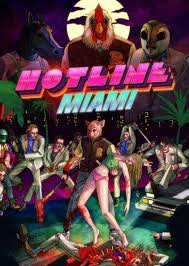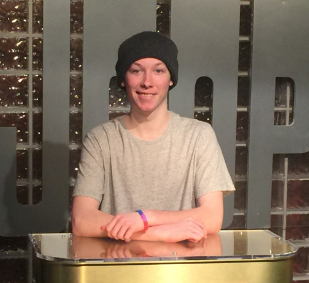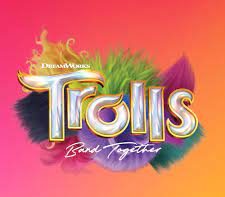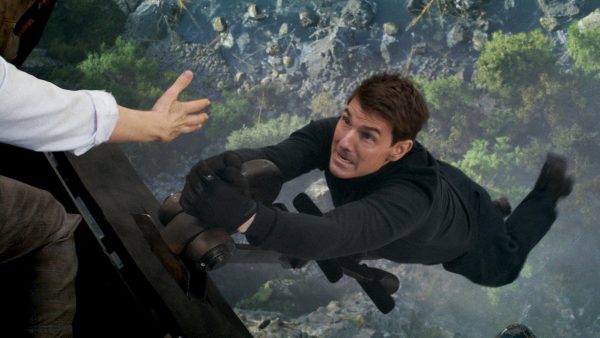Hotline Miami: The Art of Unconventional Beauty

January 16, 2020
SPOILER ALERT: This article includes spoilers from the Hotline Miami & Hotline Miami 2 Video Games
Hotline Miami was released in late 2012 as a top-down, low resolution video game that introduced us to brutal violence and an amazing and complex (and confusing) universe and story. Three years later it was followed by a sequel named Hotline Miami 2: Wrong Number. In my opinion, it’s one of the strongest examples of a video game focusing more on artistic integrity rather than appealing to the public or a certain group. It’s an incredible game, and it really is a work of art, but unfortunately a lot of people within the media seemed to miss the point of the game. A lot of media outlets called the game “disgusting,” even going as far as to say that it’s the most offensive game of all time, which is strange because it’s not even that wide spread of a game. It has a huge cult following, sure, but to the average person they have no clue about what it is.
So what is Hotline Miami, and where does the controversy come from? The first game is seen through the eyes of an unreliable narrator, nick named Jacket, and his journey into madness. The game starts with Jacket entering a room with three masked individuals. A woman on his left wearing a horse mask, a man on his right wearing an owl mask,  and a man in front of him, dressed the same way as Jacket, wearing a rooster mask. The interaction plays out with the woman saying very generalized and unrevealing information to Jacket, while the man in the owl mask only greets him with hostility. The man in the rooster mask then tells Jacket that it all started on April 3rd, 1989. The scene ends and we are transitioned to that very same date in Jacket’s apartment.
and a man in front of him, dressed the same way as Jacket, wearing a rooster mask. The interaction plays out with the woman saying very generalized and unrevealing information to Jacket, while the man in the owl mask only greets him with hostility. The man in the rooster mask then tells Jacket that it all started on April 3rd, 1989. The scene ends and we are transitioned to that very same date in Jacket’s apartment.
Once in the apartment, Jacket finds an informational pamphlet for a patriotic organization called “50 Blessings” and then gets a phone call and picks up. The person on the other end tells him that his cookies have arrived and are waiting outside his front door. Jacket goes to check and, sure enough, there’s a package right outside his door. But when Jacket opens it, instead of cookies, there’s a rubber chicken mask (exactly like the one the man was wearing in the room) and a piece of paper, containing details of a briefcase that must be retrieved from a building. The note ominously ends with “Failure is not an option.” Jacket gets in his car and goes to the building to see what the note was talking about. He gets there and it turns out that it’s actually a front for the Russian Mafia, and inside are the mobsters from that group. Jacket clears the entire building with extreme aggression and violence. Now having the briefcase, Jacket drops it off in the dumpster a few blocks away (this is where the note told him to drop it off). Once dropped off, a homeless man starts shouting from the entry of the alley way, angry that someone is in his alley. Jacket approaches the man but the man doesn’t want to talk. Jacket kills the man in self defense. Jacket walks towards his car but before getting in, takes off his mask and throws up at the thought of everything he just did that night. He shakes it off and returns to his apartment. He goes to a convenience store for some snacks where he finds his friend working. The friend (nicknamed Beard) makes some small talk and then tells Jacket to take whatever he wanted, saying, “it’s on the house.”
A little bit of time passes when Jacket gets another phone call from the same mystery callers that told him to clear the building with the Russian Mafia. Once again, the caller tells Jacket to clear a building with more mobsters in it. He complies, once again usually brutal force against them. This same kind of scenario happens for the next few weeks. Jacket gets a call, clears a building, then goes to a place afterward. It’s important to mention that Beard actually works at several different places. He works at a convenience store, a pizza place, a bar, and a video store. As Jacket clears buildings and does the callers bidding, he notices that there are quite a few people in rubber masks within these buildings, all of them either dead or being tortured for information. Jacket, realizing that he’s not the only one doing this, starts to really question who the callers are, but not enough to stop him from doing any of their bidding. While clearing a building, he finds a woman being abused. He rescues her (surprisingly) and brings her back to his apartment, where they start developing a relationship. After clearing out another building, the phone rings, and the callers tell him to go to a building that serves as an HQ for a phone company, where a “prank caller” needs to be dealt with. Jacket arrives, finding all of the employees were slaughtered, and goes to the manager’s office to find a man in a biker helmet hacking the managers computer. They fight, and Jacket comes out alive, with the biker dying, exclaiming that he was “too close for it to end now.” Shaking it off, Jacket returns home.
After some time, Jacket starts seeing some very strange things. Bodies that aren’t really there, bodies that talk to him, etc. He goes to sleep and wakes up back in the room with the three masked individuals. The woman exclaims that she doesn’t like the picture that’s forming here, and the man in the owl mask, once again, only greets him with hostility. The man in the rooster mask offers Jacket three predictions:
“First, someone is not who you think he is.”
“You’re going to lose something important to you.”
“On July 21st, you will wake up in a bigger house.”
Jacket arrives back in his apartment and business goes back to normal. Phone call, killing, store, and home. He starts noticing that Beard is no longer manning any of the stores he goes to after his jobs, and is instead replaced by a bald man who acts very hostile towards Jacket for the remainder of the game. He comes home one night to find the door kicked in and his girlfriend dead on the bathroom floor, while a man in a rubber rat mask sits on his couch, and shoots Jacket. Jacket, having an out of body experience, has another conversation with the man in the rooster mask. The other two are noticeably gone this time. The man in the rooster mask assures Jacket that everything he does from here on will be pointless, and that Jacket will never see the bigger picture. He then tells Jacket to go across the hall to get some sleep. As Jacket walks, his clothes turn into a hospital gown, and Jacket sees himself in a hospital bed. He realizes that everything that we had been viewing from the beginning to this point had been a mix of memories and coma dreams. His head symbolically explodes, and on July 21st, wakes up from his coma, confirming all three of the man in the rooster mask’s predictions. He lost the one he loved, HE wasn’t who he thought he was, and on July 21st, wakes up in a hospital. Seeking revenge, Jacket escapes the hospital and goes on a search for the leader of the Russian Mafia, believing that they are the cause of his loss. He finds the leader of the Mafia and kills him. Believing his fight to be over, he walks to the balcony of the building where the leader was, tosses his mask to the side, and lights a cigarette. He pulls a piece of paper out of his pocket, looks at it one last time, and throws it off the building.
The game isn’t quite done yet, though. We rewind to May, where we start seeing the perspective of the biker that Jacket killed. We learn that he was close to uncovering the truth of the phone calls being made, and as we see him hacking the computer, we see Jacket walk in. We obviously already know how this played out, but in a turn of events, the biker wins the fight easily. He tracks down the address found in the computer and finds a janitor retreat to a back room. The biker follows, finding a computer and, if you collected the right amount of items throughout the game, can enter the password. The password is “I WAS BORN IN THE USA.” He then follows the janitor down a manhole in the backroom and confronts them. They admit that they are part of a patriotic organization called “50 Blessings” who are trying to topple a so-called “Russo-American Coalition.” In this universe, Russia and America went to war, and formed the Russo-American Coalition to prevent further destruction of either countries. Jacket wasn’t just killing mobsters, he was killing politicians too. The biker, satisfied with the information, kills or leaves (depending on the players choice) the two janitors and retreats to his bike outside, leaving the city and, fearing he knows too much, goes into hiding.
So that’s a summary and analysis of the first game. It brings up quite a few interesting concepts, and as if the story wasn’t confusing enough, it gets even more convoluted in the second game. To prevent this article from being 10 pages long, I’m only going to be focusing on the events that relate to Jacket, as the second game introduces several new characters and story lines, each still amazing but again this paper is already getting long. The main reasons that Hotline Miami 2: Wrong Number such a confusing story to follow is that it’s not in chronological order and that, as I said before, there are a lot of newly introduced characters to the story. But again, only focusing on the Jacket related story line. So even though Jacket is the main character in the first game, and still is a huge role in the second game,  you don’t play as him at all if I remember correctly. He is shown for a few scenes but other than that you don’t. Instead, we play as Richter, the man in the rubber rat mask that shot Jacket in the first game. We are introduced to him as an adult loner who takes care of his mother at home. It’s mentioned that she has medical problems and that the doctor told her to rest, but it’s never revealed to us what her condition actually is. As the days go on, Richter starts getting the same sort of calls as Jacket. He complies with the missions, and as he continues, he finally gets caught by the police and sent to jail. When told he has a visitor, he goes to the booth and two scraggly men come up to him and tell him that they appreciated the work he did. Although Richter doesn’t recognize them, these men are the same men that the biker found in the building that were dressed as janitors. They leave him be, and soon after a prison riot starts, giving Richter time to escape the prison. He flees to Hawaii, and goes into hiding. This all took place in 1989.
you don’t play as him at all if I remember correctly. He is shown for a few scenes but other than that you don’t. Instead, we play as Richter, the man in the rubber rat mask that shot Jacket in the first game. We are introduced to him as an adult loner who takes care of his mother at home. It’s mentioned that she has medical problems and that the doctor told her to rest, but it’s never revealed to us what her condition actually is. As the days go on, Richter starts getting the same sort of calls as Jacket. He complies with the missions, and as he continues, he finally gets caught by the police and sent to jail. When told he has a visitor, he goes to the booth and two scraggly men come up to him and tell him that they appreciated the work he did. Although Richter doesn’t recognize them, these men are the same men that the biker found in the building that were dressed as janitors. They leave him be, and soon after a prison riot starts, giving Richter time to escape the prison. He flees to Hawaii, and goes into hiding. This all took place in 1989.
One other masked character we are shown is Jake, who is shown to love his country, but the player can tell from context clues that his patriotism may be misplaced. When in his apartment, we see several confederate flags and banners. He, of course, gets the same phone calls that Jacket and Richter had been getting, and is happy to comply. After finding a stash of money in one of the buildings, he wants to get a confederate flag tattoo at a Russian tattoo parlor, but can’t get it until next week. Outraged, Jake leaves, and calls the Russian tattoo artist several insulting terms. Being a patriot, Jake goes to 50 Blessings with a plan to topple the Russo-American Coalition by having people kill Russians through calling them. It’s obviously pretty funny because that’s already what they are doing, but because Jake now knows too much, they kill him. This also happened in 1989 along with the Jacket story line and most of the Richter story line.
We then flashback to 1985 where we see Jacket and Beard as soldiers in the military, and we can tell by their dynamic that they are good friends. A journalist asks if he can take a picture of Beard and Jacket together and they comply and gives the Polaroid to Jacket. After this, we learn that they are part of an elite team and are ordered to do very dangerous missions involving clearing out Russian military forts. They proceed through each mission, and eventually their commanding officer tells them that they have one more before they get to go home. This same officer just got promoted to Lieutenant General and calls Beard in to his quarters to celebrate. Beard notices that he is not exactly very happy about the promotion, and when Beard asks him about it, the General eludes to the fact that America is going to lose the war. Beard and his team do the mission that was promised to be their last with ease, but when they get back the General has been told that there’s yet another mission to do. It’s obvious to both the team and the General that whoever is calling the shots is trying to get them killed. They are tasked with taking over an entire power plant by themselves. Surprisingly, they do it, and as they are making their escape, the elevator they were about to take blows up, killing a soldier named Barnes, and badly injuring Jacket. Beard carries Jacket out of the plant, and as Jacket thanks Beard, Beard tells him not to worry about it, saying, “It’s on the house, buddy.”
They finally get to go home, and we see that Beard and Jacket live far away from each other, Jacket living in Miami and Beard living in San Francisco, although they stay in touch with long distance phone calls. One day, while Beard is asking if Jacket had sent him that Polaroid yet, Beard says that there’s something happening outside and that he’ll be right back. He steps outside of his convenience store and sees a bright flash. San Francisco had been nuked by Russia. Every interaction between Jacket and Beard in the first game was all in his head from not being able to cope with his best friends death. When he gets the calls and finds out that the targets are Russians, he finds great pleasure in killing them because he seeks revenge, not even considering the circumstances or weight of his actions.
So the war is over, after nuking San Francisco both America and Russia agree to a truce and form the Russo-American Coalition to prevent any more harm being done to either country through nuclear warfare. As a result, corruption ensues as the political figures and Russian Mafia become, more or less, intertwined. This was what made 50 Blessings make the phone calls. To topple the Russo-American Coalition and regain control of America by the Americans.
So all this happens, and after the Mafia being built up and destroyed again through other story lines in the game, we cut to Richter at his house in Hawaii watching TV with his mother. While watching the news, it is reported that a Russo-American Coalition political conference was raided by masked assailants linked to the 50 Blessings organization. They kill several political figures, almost all of them being Russian. Russia sees this as an act of war, and decides to nuke the US as a last straw decision. We then cut to every character introduced in the games in their houses or jail cells as the nuke continues to destroy everything, and, with that, the credits start rolling.
So there’s obviously a lot to process here, but it’s not as complicated as it seems. Jacket and Beard were in the army together, and when getting back they go their separate ways, and after Beard’s death, Jacket becomes a tool that 50 Blessings uses to destroy the Russian Mafia, which he subconsciously doesn’t question too much because he loves the feelings of revenge he feels toward killing the Russians who nuked San Francisco. The paper that he throws off the balcony is most likely the picture of him and Beard together during the war and, realizing he wasn’t there during the events of the first game at all, throws it off the balcony as a symbolic representation of him coming to accept this fact.
Hotline Miami was a game that brought vibrant colors, amazing music, and incredible storytelling capabilities. It was a game that showed true artistic integrity. It was a game that was brave enough to make a statement about mental illness, political corruption, and the harsh nature of war itself, and it’s a game that deserves more praise and attention. Thanks for reading, check out the games. They’re really good. If you have any additions, comments, questions, or fact corrections, feel free to leave them below!





